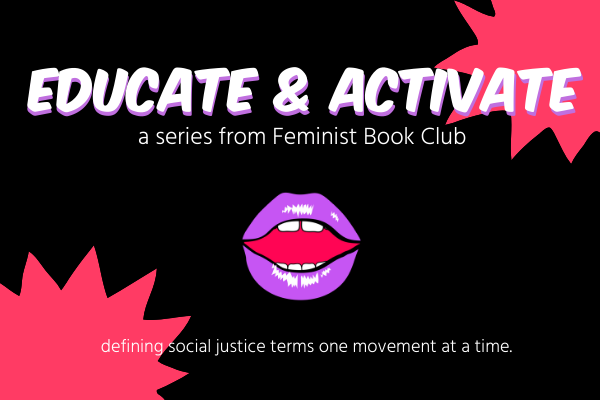Feminist Book Club blog contributors are working together to create posts as an “Educate & Activate” series. We will define a term or movement, provide historical context, and give you additional resources to learn more. We believe that an educated populace can be better activists, accomplices and co-conspirators. It is important to note that these are meant to be brief descriptions and not inclusive or exhaustive of all resources. We urge you to continue being curious, and continue learning more.
Definition
What is Second Wave Feminism? The second wave (1963-1980s) begins with Betty Friedan’s The Feminine Mystique published in 1963. Some of the achievements in this era were: The Equal Pay Act of 1963 that aimed to abolish gender pay gap, married and unmarried women had the right to use birth control, Title IX provided educational equality, and Roe v. Wade (1973) assured reproductive freedom.
First usage
A New York Times article by Martha Weinman Lear, “The Second Feminist Wave” first used the wave metaphor. She wrote, “Proponents call it the Second Feminist Wave, the first having ebbed after the glorious victory of suffrage and disappeared, finally, into the great sandbar of Togetherness.”
Historical context
The second wave feminism began in the US in the early 1960s with the publication of Betty Friedan’s The Feminine Mystique in 1963. It discussed systemic sexism where women’s’ place was in the house. Friedan also argues that women were unhappy because they could not exercise their intellectual and creative freedom.
The slogan for the second-wave feminism was “The Personal is Political.” It connected women’s cultural and political inequalities and wanted women to identify how their personal lives were a reflection of sexist power structures.
During this time, President John F. Kennedy appointed Eleanor Roosevelt to lead his 1963 “President’s Commission on the Status of Women” which cataloged “a national pattern of employment discrimination, unequal pay, legal inequality, and meager support services for working women that needed to be corrected through legislative guarantees of equal pay for equal work, equal job opportunities, and expanded child-care services.” The Equal Pay Act of 1963 aimed to reduce the gender pay gap and the Civil Rights Act of 1964 prohibited employers from sex-based discrimination.
The Civil Rights Act of 1964 prohibited employment discrimination based on race, color, religion, national origin, as well as prohibiting discrimination on the basis of sex in Title VII. The National Organization for Women (NOW) formed in 1966 and set an agenda for the feminist movement. An explicit goal of NOW was passing the Equal Rights Amendment (ERA) to guarantee equal rights for women. Despite being introduced in Congress in 1923 and passed in 1972, the ERA failed to receive the 38 state ratifications necessary and is yet to be adopted today.
Another important milestone was the US Food and Drug Administration’s approval of the birth control pill in 1960. It freed women from the limitations of pregnancy and childbearing as they could control reproduction. Some six million women were using the pill within five years of the pill’s approval.
One incident associated with second-wave feminism is an event staged in September 1968 by New York Radical Women. The group demonstrated at the Miss America Pageant in Atlantic City, New Jersey, to bring attention exploitation of women by the contest and society. The group crowned a sheep Miss America and tossed items of women’s oppression, like girdles, curlers, bras, and high-heeled shoes into the Freedom Trash Can which resulted in the incorrect and notorious association of feminism and “bra burning.”
Additionally, second-wave feminism tried to include Black feminists. White feminists saw gender as the main reason for being excluded from different aspects of their life while Black feminists saw both gender and race as obstructions. Black feminists like bell hooks, Michele Wallace, Alice Walker, Mary Ann Weathers, and Bettina Aptheker. However, during the National Black Feminist Organization organized in 1973 in New York City, Black women activists acknowledged that certain goals like violence, abortion, day care, and maternity leave were also important to African American women. Due to some common ground, white and Black feminists did manage to unite and create a working relationship.
An important result of second-wave feminism was consciousness-raising groups which began in the 1960s New York and Chicago and spread across the country. These groups, consisting of less than a dozen women, provided a space for women to verbalize how they were oppressed and to raise consciousness about their problems. It resulted in women having a bond of sisterhood that destroyed the isolation that women felt.
Lastly, second-wave feminism included lesbians after the controversial incident where Freidan called lesbians a “lavender menace.” Michela Griffo, Rita Mae Brown, and other activists, who self-identified as Lavender Menaces, stormed the Second Congress to Unite Women in May, 1970 and announced that “Lesbianism is a women’s liberation plot.” Within a year, NOW had adopted a resolution recognizing lesbian rights were “a legitimate concern of feminism.”
Resources for Further Education:
Books:
The Feminine Mystique by Betty Friedan
Sexual Politics by Kate Millett
The Dialectic of Sex by Shulamith Firestone
The Female Eunuch by Germaine Greer
Separate Roads to Feminism: Black, Chicana, and White Feminist Movements in America’s Second Wave by Benita Roth
Sisterhood Is Powerful: An Anthology of Writings from the Women’s Liberation Movement edited by Robin Morgan
Feminist Coalitions: Historical Perspectives on Second-Wave Feminism in the United States edited by Stephanie Gilmore
Catherine Russo’s documentary, A Moment in Her Story, on second-wave feminism including a part on the lavender menace
The miniseries, Mrs. America, that is based on second-wave feminism, available on Hulu.


